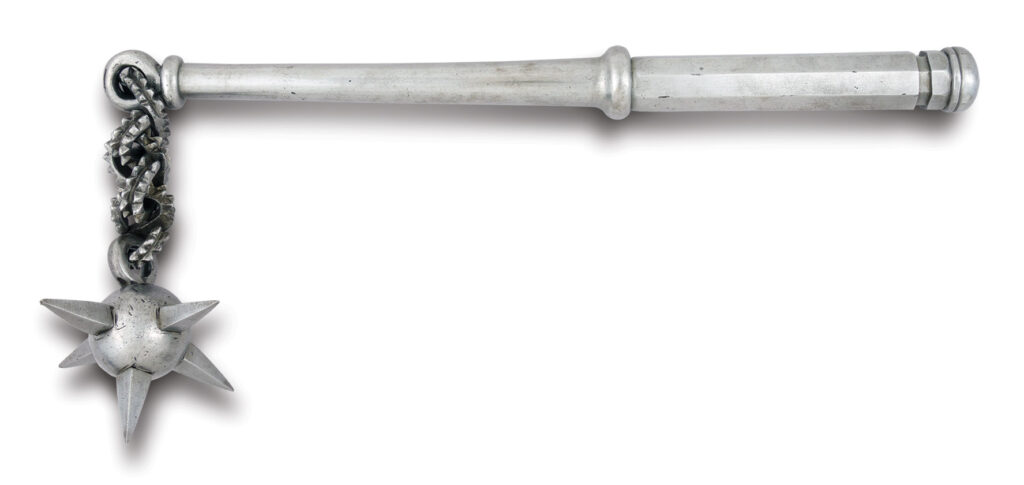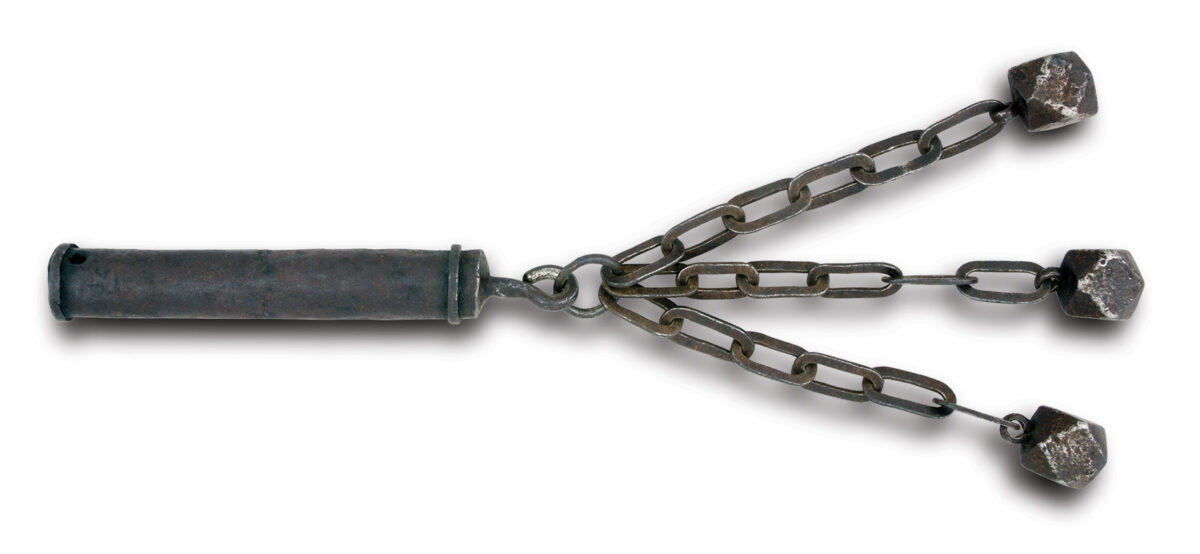As an instrument of war, the flail was a handheld, two-piece, jointed weapon, consisting of a wooden handle of varying length (up to 5-6 feet long) and a shorter, perhaps 1–2-feet long, heavy impact rod serving as a “striking-head” which was attached to the handle by a flexible rope, leather strap or chain links, allowing it to swing freely up and down and in a full circle.
By making a sweeping, downward blow with the flail’s handle, the weapon’s wielder greatly increased the impact energy of his blow through the increased energy generated by the centripetal force of the free-swinging “striking-head,” thereby inflicting a more powerful blow on the target. Some flail wielders even increased the lethality of their flail’s striking-head by replacing the rod with a longer-chain-linked, spiked head, orb-shaped ball, creating the Kettenmorgenstern (chain morning star).
Peasant farmers just trying to survive medieval combat added spikes and metal studs, considering any lethal enhancement a battlefield “plus” if it helped them get through a battle alive.
Flail weapons are best classified as “peasant levy’ weapons” since they evolved from the flail grain thresher, an agricultural tool typically used by farmers to separate grain from their husks (dating from ancient Roman times) through heavy beating, and therefore one of the commonly-available farming tools that peasant levies who were involuntarily conscripted into military service had readily available.
Other such peasant farming/foresting tools that could be quickly converted into military use when peasants were called up included axes, billhooks, knives, adzes and heavy mallets. Certainly, at least by the 15th century—as Czech Hussite peasant infantry who fought with flails demonstrate—flails were in use and there are accounts confirming its use through the 17th century.

Variations of the flail weapon were developed in widespread world regions. In medieval Russia and East Asia, steppe warriors wielded kisten, flails with smooth metal or bone balls attached to the haft by rope or a leather strap. Similar, flail-like, hand-wielded impact weapons were developed by the Chinese (nunchakus, three-section-staff, and the knotted-rope knout) and the Koreans (pyeongong). Yet, the most famous flail-pattern weapon may never have been part of the Medieval armored knight’s weapons array.
Today, the most popular and well-known image of the flail weapon—perpetuated by modern-era novels and films—is of fully-armored Medieval knights (literally) “flailing” away in knight-to-knight combat, bashing at each other brandishing short-hafted “morning star” flails sporting long-chain-linked, spiked balls.
Yet, today’s medieval armored knight combat historians are at odds as to whether such weapons even existed. Contemporary paintings depict such weapons, and post-medieval examples do exist, but many historians doubt if these were more than conceptual imaginings. Indeed, a short-handled, long-chained “morning star” flail, in practical use, could have been more dangerous to the flail weapon’s wielder than to the weapon’s target!
Certainly, the flail was used in medieval combat, but the version depicted in 19th century and later romantic “knighthood” novels and films was likely never used in knightly combat.






